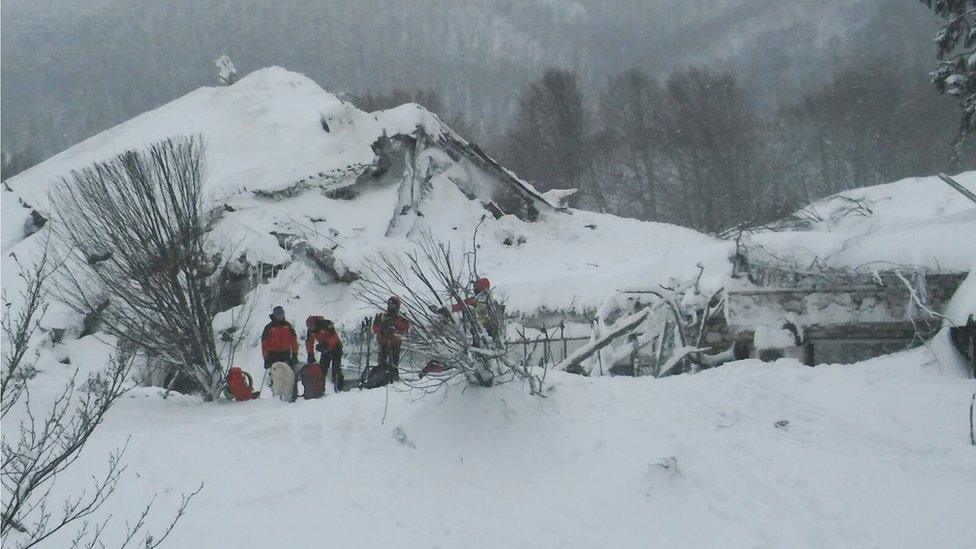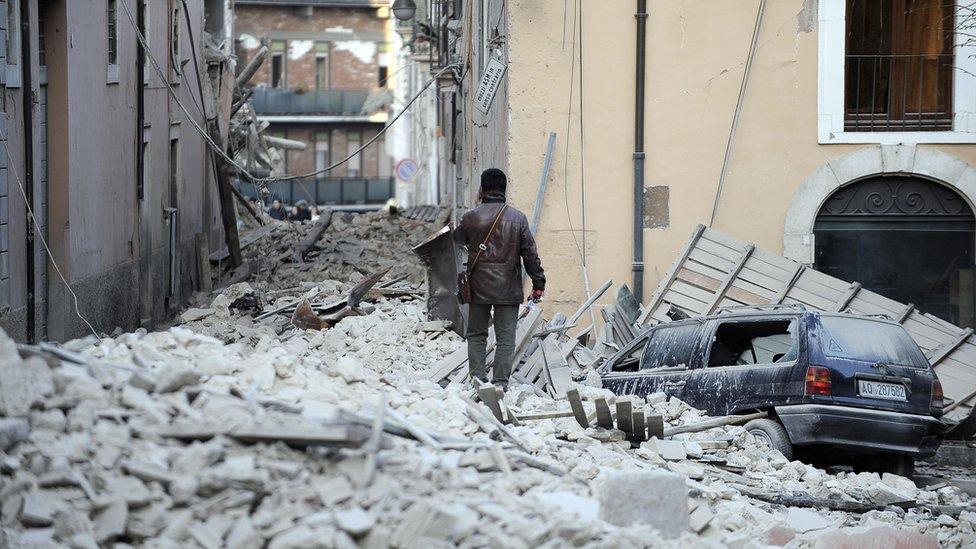Italy avalanche: A cruel coincidence
- Published

Rescue workers had difficulty reaching the Hotel Rigopiano in Farindola
It's a cruel coincidence that the latest swarm of big quakes to strike the Apennines region of Italy should occur just after a period of very heavy snow.
The sizeable tremors - four magnitude fives in the space of four hours on Wednesday - appear to have triggered an avalanche that swept into the Rigopiano hotel in the Grand Sasso resort area, killing many of its occupants.
The deep drifts have made it difficult for emergency workers to reach the smothered building and deal with the crisis.
Earthquakes cannot be predicted but seismologists had suspected this particular area of central Italy would experience another batch of serious tremors sooner or later.
What we're seeing is a classic case of gap filling - of previous quakes stress-loading adjacent zones, which then fail themselves as a direct consequence.
There are a multitude of different faults that cut through the Apennines mountains but the key players over recent months have been two neighbouring faults called the Laga and Vetorre faults.
August's big Magnitude 6.2 jolt, which killed 299 people, occurred on the northern end of the Laga, and ruptured the crust further north still, on to the Vetorre fault.
Then came October with a swathe of quakes that broke much of the rest of the Vetorre. But the stress, according to the seismologists, wasn't just sent north, it was loaded south as well - south of August's event.
And it's in this zone that we have now seen a series of quakes in the past day or so. About a dozen Magnitude fours and fives.

The L'Aquila event in 2009 would have helped prime the latest quakes
It is a zone that would also have been put under pressure as a result of the infamous L'Aquila quake (M6.2) in 2009 which is much further to the south. It has been loaded from both sides.
Dr Richard Walters is affiliated to Britain's Nerc Centre for Observation and Modelling of Earthquakes, Volcanoes and Tectonics (Comet). He says preliminary models produced by his group and by geophysicists in Italy had all been pointing to similar outcomes.
"It is commonly understood that when earthquakes slip, they load the adjacent faults and bring them closer to failure," he told BBC News.
"It was clear after L'Aquila in 2009 that this southern end of the Laga fault had been loaded, and it's also been brought closer to failure from the stress transfer from the August and October quakes to the north.
"It is not a surprise therefore that this area is where the sequence is continuing. It may be that this is it - that things will die down and we will not have another large quake in the foreseeable future. But I'm afraid it's not possible for us to rule out that there will still be another large quake."
Unfortunately, this clustering in space and time is what earthquakes do. And for the Apennines, one of the most beautiful parts of Italy, you just have to look back to 1997 or as far back as 1703 to see that this is the case.

What drives earthquakes in Italy?
On the grand scale, Italy's seismic problems are driven by the great collision between the African and Eurasian tectonic plates. But look closer at the specifics of any quake and the details are much more complicated.
The Tyrrhenian Basin, or Sea, which lies to the west of Italy, between the mainland and Sardinia/Corsica, is slowly opening up.
Add in movement in the Adriatic where the crust is rotating in an anti-clockwise direction, and you have a fiendishly complex picture.
Italy is literally being pushed and pulled every which way.
Scientists say all this is contributing to extension, or "pull-apart", along the Apennines which works at a rate of 3mm per year.